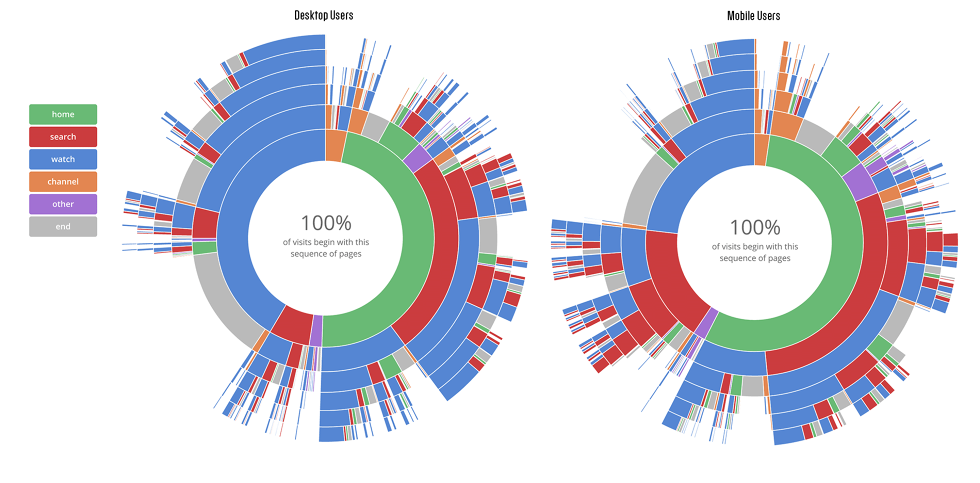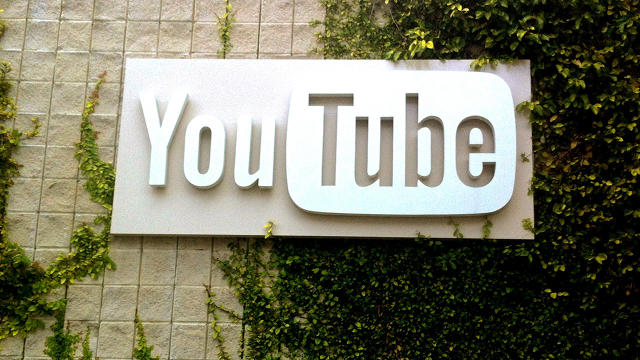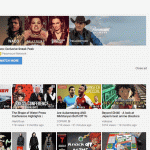To take on HBO And Netflix, YouTube had to Rewire Itself
To change into a “destination” and maintain cellular viewers hooked, YouTube realized it needed to fix itself, from its development platform to its AI.
may 15, 2015
The warfare over our eyeballs is heating up, and that’s the reason mostly a good thing for people who like to take a look at displays. just as Meerkat, Periscope, and Snapchat elbow each other in a combat over appointment viewing, and digitally native firms like Netflix and Hulu duke it out over the way forward for television and flicks, an outdated-college competitor displays up and throws down a vivid new gauntlet: ultimate month, HBO Now launched just in time for wire-cutters to catch the debut of the new season of game of Thrones. there’s by no means prior to been such an abundance of high quality, without difficulty available tv preventing for our consideration.
YouTube, on the other hand, has discovered itself on this new golden age of video with a significant handicap: whereas its overall viewership was once rising, most of that boom was once taking place across the online at large, outside of its personal web page and apps. That made it more difficult to capture eyes and advert bucks, and to attraction to cherished cellular users. When Susan Wojcicki turned into CEO last 12 months, she would continue efforts to become the way in which it served commercials and engaged with its creators, pouring money into sure channels and promoting them heavily.
however there used to be a extra urgent, underlying problem for the video massive: the way it constructed and tested its code was once rusty. The outdated pipes operating below the world’s biggest video website online had been making it trickier to construct the kind of new features that would preserve users observing extra, fairly than browsing over to, say, Netflix or Hulu.
“As a trade, it’s kind of a prone state of affairs to be in,” says Cristos Goodrow, a director of engineering at YouTube. “We’re not building as strong of a relationship with viewers. we’ve got very little leverage to take a look at to make the experience better for customers.”
So in 2012, the corporate undertook a major, go-department initiative to fix those issues. Code-named InnerTube, the undertaking, which Google has not in the past discussed, would deal with everything from its development platform to its computer finding out algorithms, a retooling that may allow engineers and designers to more quick check and craft a extra attractive, addictive expertise on more screens. “it is a exchange that we needed to make if YouTube used to be going to continue as a very powerful factor on the net,” says Goodrow of the ongoing InnerTube mission. “We needed to turn out to be a vacation spot.”
How Fixing YouTube’s visitors problem become An Emergency
all of it began with an infographic. In 2012, Kerry Rodden, a user experience researcher at the firm, created a data visualization breaking down YouTube viewership job that soon began to indicate up in meetings right through the corporate’s headquarters. It confirmed that slightly than turning to YouTube.com or one of the most service’s many apps on telephones, TVs, and pills, most of us were observing YouTube movies elsewhere: in blog posts, information articles, links on fb and Twitter and so forth: all the tens of millions of YouTube embeds and links woven into the net. Having its person base fractured across the online supposed that YouTube’s capacity to maintain, find out about, and monetize users would be limited.
The significance of YouTube’s skill to earn revenue from its users can hardly ever be overstated. while it boasts over 1 billion month-to-month viewers, the still-unprofitable website online raked in a mere $4 billion in income remaining yr, in step with The Wall side road Journal. examine to that Netflix’s $5.5 billion of 2014 income on only 50 million subscribers and it becomes easier to take note why corralling its users into the identical location changed into this sort of giant precedence.
Fixing this drawback would also assist YouTube future-proof itself against a growing record of rivals. With the launch of YouTube song Key, the website is officially a competitor to Spotify, who is reportedly plotting to transfer further into YouTube’s territory by way of including video to its tune streaming carrier.

The challenge would commence by piecing YouTube itself back collectively. The proliferation of recent units—and accompanying demand for YouTube on all these monitors—had advanced extra quick than the company’s instrument development infrastructure may maintain up with. as a result, YouTube’s development course of turned into fractured: Its XBox app was constructed on one observe, while its iOS app was built on some other, and so forth.
“Over time, the friction of having these different methods and ways of building was beginning to gradual us down,” says YouTube engineering director Andrew Berkheimer, relating to the disjointed developer platforms that had Frankensteined their way into existence at YouTube. “So we recognized that was going to be a big downside, especially as mobile goes to develop into the dominant part of what we do.”
Even worse—and the team seems embarrassed to admit this now: YouTube was unable to gather certain analytics from person conduct on cellular gadgets. That meant that if I lay in mattress with my cellphone all evening binging on Louis CK clips and chuckling to myself in the darkness, the laptop version of YouTube would have had no thought.
“it can be crazy that we weren’t using data from cell,” admits Goodrow. “after we at last started doing it, it bolstered the fact that there are a huge choice of customers who are cell-simplest,” he says. As the period of time U.S. adults spend looking at video on their phones continues to extend, a blind spot like this will develop into a serious aggressive liability.
indeed, with the aid of 2012 a majority of YouTube’s viewership was taking place on cell gadgets. And even though its engineers had assembled a fleet of apps for every imaginable monitor, the rotting building infrastructure and fragmented process had made it exhausting to do easy issues on mobile, like run A/B assessments on customers to review new design elements and functions, and to in most cases measure consumer conduct.
the new machine is designed to undo these technical hurdles. “InnerTube will allow us to test way more important modifications to the the UI in a managed method,” says Goodrow, who recommendations at main enhancements that are “within the works.”
transferring faster, Breaking extra issues
Even with out dated infrastructure, mobile building has one main drawback in comparison with building for the net: it can be slow.
“each new model of the app took six weeks, which resulted in an extraordinarily long iteration cycle and studying cycle,” says Berkheimer of the previous system. This supposed that if a brand new feature wasn’t performing as expected, it will be weeks prior to they may swap it out. in a similar way, any new design concepts and functionality have been trapped on that painfully drawn-out development cycle, a headache for engineers used to pushing products to the online, where modifications are instantaneous and iteration is constant.
that is another factor InnerTube aimed to fix. thanks to a new, extra flexible API, engineers can now push modifications throughout systems more easily than sooner than, and make sure updates to apps on-the-fly without needing to resubmit the app each and every time. this method additionally lets in modifications to be easily undone, which lets builders scan extra freely with out fear of getting a busted app sitting in an app store for days and even weeks.
“within the previous world, you needed to be very cautious about what you set out there, because you could not flip it off,” says Berkheimer. “Now we will also be bolder about what we put out there, as a result of we now have the right way to flip it off if we want to. And if it does work, we will just as easily turn it on for everybody as smartly.”
From tiny tweaks to main app updates, the cell construction course of at YouTube is now a lot smoother and more efficient than earlier than. certainly, post-InnerTube, that six-week lag has disappeared and YouTube engineers are able to push new versions of its apps into production within the span of 1 week.

it is usually more uncomplicated to build new things now. The YouTube children app launched in late February, for example, was considerably more uncomplicated to construct as soon as the foundational groundwork was once relaid through the InnerTube challenge.
YouTube children takes purpose directly at Netflix’s personal efforts to seize the eye spans of younger audiences, a key a part of carving out future marketshare in streaming video. that is one thing Netflix began specializing in in earnest just about four years ago. With its development infrastructure freshly rehabbed, YouTube hopes it’s going to be capable to reply to opponents slightly extra nimbly.
How Deep finding out Leads Us To Cuter Cat Clips
Why does it subject that i love to look at Louis CK’s bit on getting freaked out when he is high? small print like these are a crucial piece of the YouTube consumer expertise puzzle: suggestions.
As part of the InnerTube venture, YouTube’s engineers completely overhauled the way in which its video advice engine works. it is going to appear to be a minor element to the tip consumer, however there’s various technical plumbing at the back of those little packing containers below the “recommended” heading which is now so distinguished on YouTube’s homepage. The relevance of those videos has huge price for the corporate: the simpler the suggestions, the extra addictive the expertise. The extra time you spend taking place video rabbit holes, the extra earnings for YouTube and its creators. (it is also much less time it’s essential to spending staring into the app of a competitor.)
To perfect these suggestions, YouTube tapped into the Google Deep learning mission, formerly known as Google mind. that is the factitious intelligence undertaking that focuses on deep studying and neural networks, a local wherein Google (like fb) has proven an extreme and growing pastime (most lately by buying a synthetic intelligence startup referred to as DeepMind). someday, the Google Deep learning challenge—probably the most issues that futurist Ray Kurzweil is working on at Google—might replicate or outdo the complexity of the human mind. within the intervening time, its neural networks are perfect for issues like speech attractiveness—or finding new movies to watch on YouTube.
“We’re the use of neural networks that are ten occasions greater than the neural networks I keep in mind that working on two decades ago,” says Goodrow. “they’ve lots of nodes and we’ve trained them on trillions of observations. because of that, we can have techniques that better learn the sorts of issues that you are considering.”
in this case, the enter information is the YouTube process of tens of millions of customers—no longer just which videos we all watch, but details like how long we watch them, which ones we favourite, and which of them we skip past. it is a bit like the Amazon-type, collaboratively filtered recommendation engine (“in case you preferred that, you’ll like this”), but supercharged with artificial intelligence. they also brought a button that lets customers disregard recommendations, something that, incredibly, wasn’t there first of all.
the brand new adaptation is a big improvement on the outdated, regression-primarily based algorithm YouTube used for suggestions, Goodrow explains. while that approach used to be good at memorizing relationships between videos, it could combat in unfamiliar scenarios. The neural network way is a lot better at inferring issues about videos that are new, or about video-to-video relationships that in any other case lack historical data. “It does a significantly better job of predicting what’s important about this consumer and their watch history that might say they’ll like this new video,” says Goodrow.
fairly, the YouTube recommendation algorithm would not draw inputs from some distance beyond the confines of YouTube itself. chances are you’ll assume that mining our Google search histories for clues about what videos we would like would pay off. Nope, Goodrow says.
“The challenge is that web search historical past may be very very wide.” just because you Googled for lend a hand together with your taxes does’t imply you wish to have to observe YouTube movies about the ins and outs of U.S. tax legislation.
To additional support video discovery, YouTube’s engineers gutted the website online’s search performance and replaced its proprietary video search engine with the same technology that powers Google search. After running some A/B experiments—again, thanks to refinements enabled by InnerTube—the workforce was once ready to verify that, certainly, Google’s core search algorithm was once simpler than what YouTube’s (much smaller) crew had cobbled collectively through the years. “It was once like magic,” says Goodrow.

How YouTube Has Reaped the advantages
all of the issues that InnerTube has enabled—faster iteration, more suitable person testing, cell consumer analytics, smarter suggestions, and more robust search—have paid off in a major method. As of early 2015, YouTube was once eventually changing into a destination: On mobile, eighty% of YouTube periods currently originate from within YouTube itself. Even on the pc, the place customers have been sprinkling YouTube embeds for greater than a decade, fifty five% of views are going down on YouTube.com. by way of early 2015, YouTube says it can be seeing 50% yr-over-yr growth in total viewership. And a majority of those views now originate from inside YouTube’s own apps or site.
As eager because the engineering team is to flex their muscle groups, expertise is not the only issue at play here. YouTube has been investing hundreds of thousands in unique content material for years and even though the service has but to peer Netflix-sized success on that front, it’s naturally using as a minimum some of the new visitors to YouTube. the corporate has additionally been spending giant ad greenbacks offline. any person who’s taken the New York city subway within the final 12 months has considered the display commercials for YouTube’s professional companion channels—manufacturers like Vice news and “well-known Rap Battles Of history”—plastered far and wide. Or in all probability you’ve gotten seen the billboards in other markets. Or the tv industrial throughout the sector Cup. And so as to develop revenue and compete with subscription-primarily based services, YouTube indicated remaining month it might be launching an ad-free subscription service someday this year.
still, then again impactful these enormous, non-know-how-related investments may be, they’d only go to this point if the consumer experience itself wasn’t as polished—and easily adapted—as conceivable. Now that greater than half of of YouTube’s rising view counts are going down throughout the firm’s own residences, the web page is best positioned to entice folks additional down those late-night video rabbit holes. Or clutch their attention with a brand new net sequence they didn’t even know about but that algorithms determine they’d dig.
that isn’t to assert that it is all easy sailing from here. have you ever heard folks at work chat about a YouTube channel the way in which they obsess over The Jinx, sport of Thrones, or house of playing cards? higher code below the hood won’t trade that overnight, but it may possibly help YouTube work out sooner the best way to get there.
associated: Get rich Or Die LOL-ing: the reality About Making It On YouTube
quick company , learn Full Story
(164)














